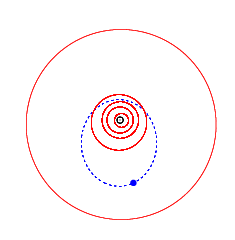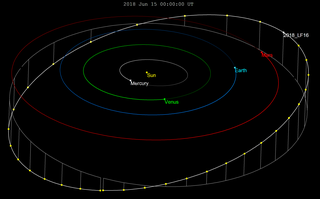
3554 Amun is an M-type Aten asteroid and a Venus-crosser. It was discovered on 4 March 1986 by Carolyn and Eugene Shoemaker at Mount Palomar Observatory. Its estimated diameter is 3.341 kilometers, making it one of the smallest known M-type asteroids. Amun was the fifth Aten asteroid to be numbered.

9950 ESA, provisional designation 1990 VB, is an eccentric asteroid and elongated near-Earth object of the Amor group, approximately 1.7 kilometers in diameter. It was discovered on 8 November 1990, by French astronomer Christian Pollas at the Centre de recherches en géodynamique et astrométrie (Cerga) at Caussols in southeastern France. It was named for the European Space Agency (ESA).
3361 Orpheus is an Apollo asteroid that was discovered on 24 April 1982 by Carlos Torres at Cerro El Roble Astronomical Station. Its eccentric orbit crosses that of Mars and Earth, and approaches Venus as well. From 1900 to 2100 it passes closer than 30 Gm to Venus 11, Earth 33, and Mars 14 times. It passed by Earth at a distance of about 40 lunar distances on 7 December 2013.
2003 SM84 is a sub-kilometer asteroid, classified as near-Earth object of the Amor group orbiting between Earth and Mars. It was first observed by the Lincoln Near-Earth Asteroid Research (LINEAR) at the Lincoln Laboratory ETS on 20 September 2003.
2012 KP24 (also written 2012 KP24) is a near-Earth asteroid and fast rotator with an observation arc of only 5 days and has a modestly determined orbit for an object of its size.
The Space Situational Awareness (SSA) Programme is the European Space Agency's (ESA) initiative designed to support Europe's independent space access and utilization through the timely and accurate information delivery regarding the space environment, and particularly hazards to both in orbit and ground infrastructure. The SSA programme is split into three main segments:
2018 CL is a micro-asteroid and a near-Earth object of the Aten group, approximately 50 metres in diameter. It was the first confirmed finding, detected on 5 February 2018, announced on 8 February 2018, of the Zwicky Transient Facility project, located at Palomar Observatory, California, in the United States.

2018 LF16 is a small near-Earth asteroid of the Amor group, first observed by astronomers with the Pan-STARRS survey at Haleakala Observatory on 14 June 2018. Based on limited observations, early estimates of its size of 213 m (699 ft) would make it extremely destructive if it collided with Earth, but predicted orbits make a collision unlikely.

2006 QV89 (also written 2006 QV89) is an Apollo near-Earth asteroid roughly 30 meters (100 feet) in diameter. It was discovered on 29 August 2006 when the asteroid was about 0.03 AU (4,500,000 km; 2,800,000 mi) from Earth and had a solar elongation of 150 degrees.
2019 SU3 is a very small near-Earth asteroid of the Apollo group, first observed by the Asteroid Terrestrial-impact Last Alert System at Haleakala Observatory on 23 September 2019. It was briefly listed on the Risk List of the European Space Agency. With a 18 day observation arc, the nominal orbit passes 0.02 AU (3,000,000 km; 1,900,000 mi) from Earth on 27 September 2084. It was removed from the Sentry Risk Table on 12 October 2019.
2020 OY4 is a very small asteroid classified as a near-Earth object that passed within 21,850 miles (35,160 km) of the surface of the Earth on July 28, 2020, with a fly-by speed of 12.4 kilometres (7.7 mi) per second. The car-sized asteroid posed no risk of impact to Earth, but it did pass within the orbit of satellites in the geostationary ring at 35,785 kilometres (22,236 mi) above Earth's equator.
2020 HS7 is an asteroid classified as a near-Earth object that passed within 42,730 kilometres (26,550 mi) of the Earth on April 28, 2020, with a fly-by speed of 9.7 miles (15.6 km) per second. The car-sized asteroid when first discovered had a 10% chance of impact with Earth, but additional observations showed that the asteroid posed no risk of impact to Earth. However, it did pass within 1,210 kilometres (750 mi) of the nearest satellite in the geostationary ring at 35,785 kilometres (22,236 mi) above Earth's equator.
2020 CW is a tiny near-Earth asteroid of the Apollo group, approximately 1 meter (3 ft) in diameter. It was first observed by the Mount Lemmon Survey on 1 February 2020, when it passed Earth very closely at a nominal distance of only 0.041 lunar distances. The object's orbital elements remain highly uncertain.
2015 ME131 (also written 2015 ME131) is a lost asteroid and a Near-Earth object (NEO). It is an Atira asteroid, which is by far the smallest group of near-Earth objects. This makes it an interior-Earth object (IEO), meaning that it has an orbit entirely confined within Earth's orbit. Because it has a short observation arc of 1.8 days, and has not been seen since 2015, it has an orbit that is only roughly calculated. It was first observed on June 23, 2015, when the asteroid was more than 1 AU from Earth and had a solar elongation of 68 degrees.
2016 NL56 (also written 2016 NL56) is a Near-Earth Object (NEO) and a Potentially Hazardous Asteroid (PHA), meaning that it has an orbit that can make close approaches to the Earth and large enough to cause significant regional damage in the event of impact. It is an Apollo asteroid, meaning that it is an Earth-crossing asteroid that has an orbit larger than the orbit of the Earth. It was first observed on July 12, 2016, when the asteroid was more than 1 AU from Earth and had a solar elongation of 163 degrees.
2017 QC36 is a near-Earth object and a potentially hazardous asteroid of the Aten group, It measures approximately 200 meters (660 feet) in diameter and was briefly observed by the Wide-field Infrared Survey Explorer on 18 August 2017 before it became a lost asteroid on the following day. As of 2020 the object has not been recovered.
2017 MZ8 (also written 2017 MZ8) is a near-Earth object and a potentially hazardous asteroid, meaning that it has an orbit that can make close approaches to the Earth and large enough to cause significant regional damage in the event of impact. It is an Apollo asteroid, meaning that it is an Earth-crossing asteroid that has an orbit larger than the orbit of the Earth. It was first observed on 22 June 2017, when the asteroid was about 1 AU from Earth and had a solar elongation of 131 degrees.
2017 DB120 (also written 2017 DB120) is a near-Earth object, meaning that it has an orbit which brings it into proximity with Earth. It is an Amor asteroid, meaning that its orbit does not cross Earth's orbit, but its perihelion is close to, but greater than, the aphelion of Earth. It was first observed on February 25, 2017, when the asteroid was less than 1 AU from Earth and had a solar elongation of 169°.
2017 SG33 (also written 2017 SG33) is a near-Earth object, meaning that it has an orbit which brings it into proximity with Earth. It is an Amor asteroid, meaning that its orbit does not cross Earth's orbit, but its perihelion is close to, but greater than, the aphelion of Earth. It was first observed on 25 September 2017, when the asteroid was less than 1 AU from Earth and had a solar elongation of 169°.

2020 VV is an Apollo near-Earth asteroid roughly 12 meters in diameter. According to the Sentry monitoring system, the asteroid has a 0.0005% chance of impacting Earth on 12 October 2033 11:43 UT. The asteroid has a short 37 day observation arc. The nominal Earth approach is on 18 October 2033 at a distance of 0.01 AU, but the line of variations (LOV) is only known with an accuracy of ±3 days. The line of variations allows the asteroid to impact Earth or pass as far away as 0.02 AU. With a diameter range of 10–22 meters the asteroid could be as large as the Chelyabinsk meteor.




